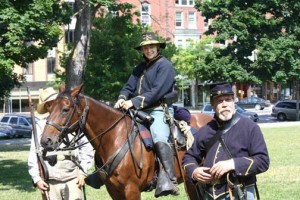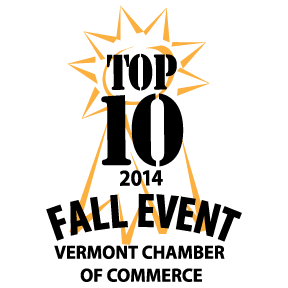
Capt. Robin Severy sits astride Parker as Tim Boutin, also of the 1st Vermont Cavalry Company K speaks to the audience during a demonstration on July 21, 2012 in Taylor Park during St. Albans Civil War Heritage Days.
Coming up over a hill bringing up the rear of a blanket of troopers, all on horseback and four-wide sent chills down Robin Severy’s spine.
It gave her a real sense how it would feel to have been part of the 1st Vermont Cavalry and was just one of several reasons she joined the Champlain Valley Historical Reenactors, Inc. (CVHRI) more than a decade ago.
Severy, of Shoreham, was among the dozens of Civil War re-enactors in Taylor Park July 21 and 22, 2012 for St. Albans Civil War Heritage Days.
“I got into it via the horses, as a way to do something different with them,” Severy said. She also felt it was a good thing for her horse, Parker.
Together, they travel to take part in parades and reenactments. Living histories, and tacticals are what Severy enjoys most and she and Parker put on a show both Saturday and Sunday here.
“That’s when we really get serious about playing the game,” she said.
“We get to see so many aspects of the troopers lives, and it is great training for the horses,” Severy said, noting how troopers during much larger events ride stirrup to stirrup, four horses wide, going down to two in narrower stretches.
“There are no spectators, just us reliving history, and feeling what life was like for the 1st Vermont Calvary, Company K,” Severy said of some of her outings.
Severy, the group’s director, explained that Company K originates out of Addison County just as it did during the Civil War.
During the weekend-long event she and fellow trooper Tim Boutin, with Rienzi, his Fiberglas model horse, offered a cavalry demonstration, and were then stationed at their camp where spectators could visit and learn more about the cavalry, the uniforms, weapons, horses, and gear.
While she usually does not play a particular role, Severy does sometimes go by the name of her great-great grandfather, Charles Henry Churchill, who was a trooper with Company H out of Rutland County. For her appearances Severy assumes the rank of a cavalry captain.
Boutin has yet to choose a specific trooper to portray.
“I’ve been visiting the Town Clerk’s office in New Haven to do research on who joined the cavalry, trying to find out more about them, and where they lived, so that I can do a reasonable portrayal,” Boutin said.
For Severy and Boutin, being members of CVHRI has been a rewarding experience, one that has proved to be very educational. They enjoy sharing their knowledge through the demonstrations and reenactments.
“The 1st Vermont Cavalry was made up of 11 companies of 100 or more troopers and their horses,” Boutin told onlookers Saturday morning.
“In 1861, 1,100 men and horses headed out from Brattleboro by train and served valiantly throughout the war as one of the most decorated groups,” he added. “They formed a six-mile long train of horses, and the troopers had gold piping on their uniforms.”
“By far the majority of horse never made it back,” Boutin said. He said there might have been about 200 that did return.
“You can imagine what all those horses do to the land, and the ones that brought up the rear were literally traveling through mud,” he said.
They rode for 14 hours each day, and the horses got the best care possible, which meant cavalry troopers had much longer days than those on foot.
Wagon trains followed behind the troopers carrying supplies, including oats. Each horse was offered 14 pounds of oats per day, and time for grazing.
Some horses developed respiratory illnesses and never made the train ride, others suffered from foot rot and lameness, and sadly some were shot.
Various sources estimate that overall between 1 million and 1.5 million horses died in service during the Civil War.
Troopers in their woolen uniforms with double-lined seats, sat atop McClellan saddles, made of rawhide.
“When they got wet, they became rather slippery, and when they dried, they cracked, so the ride could get rather uncomfortable,” Boutin said.
Men that were in the cavalry tended to be a whole lot smarter, they had more weaponry, and they often brought their own horses.
“And they were paid more – $1 a month more,” said Boutin.
Cavalry troopers were more mobile and often used as scouts.
Boutin explained that black Morgans, which were exceptional horses bred in Vermont, were very popular. He said they were often used by generals, and were often snagged by those in higher ranks.
The weapon of choice was the saber, which was a sword that was used more for its intimidation value.
“Picture a couple hundred troopers on horses charging at you with sabers pulled,” Boutin said.
“They were used more as a club, to hit people and to sever off arms,” Severy added.
“They were generally not used to stab bodies, because if you think about it, the saber would get stuck and probably pull you off your horse, or you’d have to drag the body until it slid off,” Boutin said.
Troopers also had Colts pistols and Sharps and Maynard carbines. The carbines were a .52-caliber weapon that had a dropping breechblock so that it could be loaded from the rear, making it much easier to use on horseback.
Boutin explained that the cavalry played a pivotal role in the Battle of Cedar Creek, and were instrumental in the capture enemy soldiers and their general.
“Under the lead of George Armstrong Custer the cavalry encircled and overtook an entire wagon train,” Boutin added.
By ANN HAWKSBY
St. Albans Messenger Correspondent



